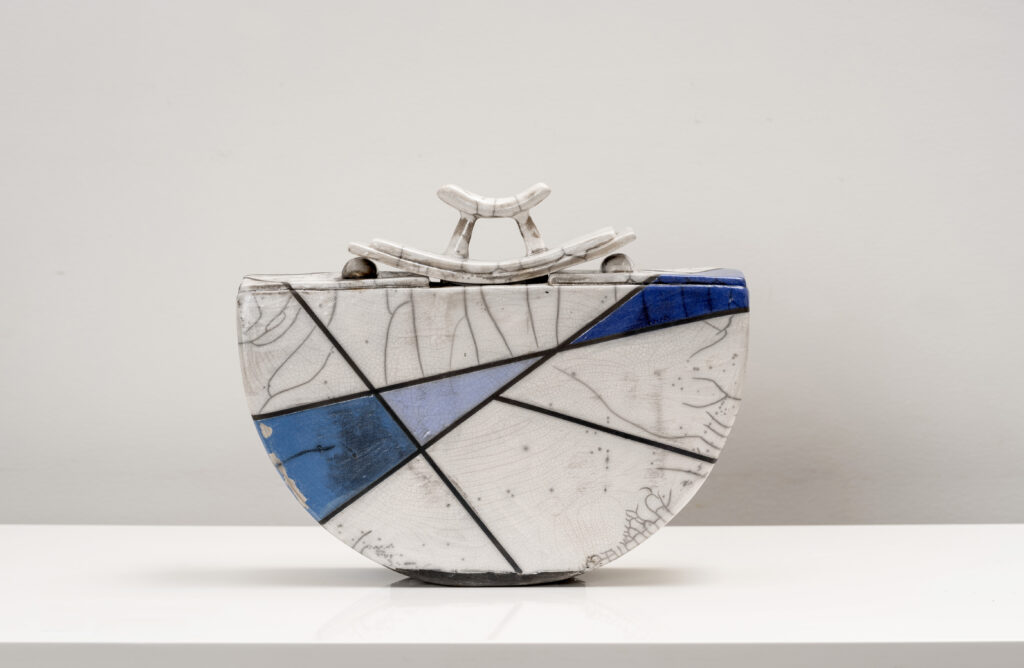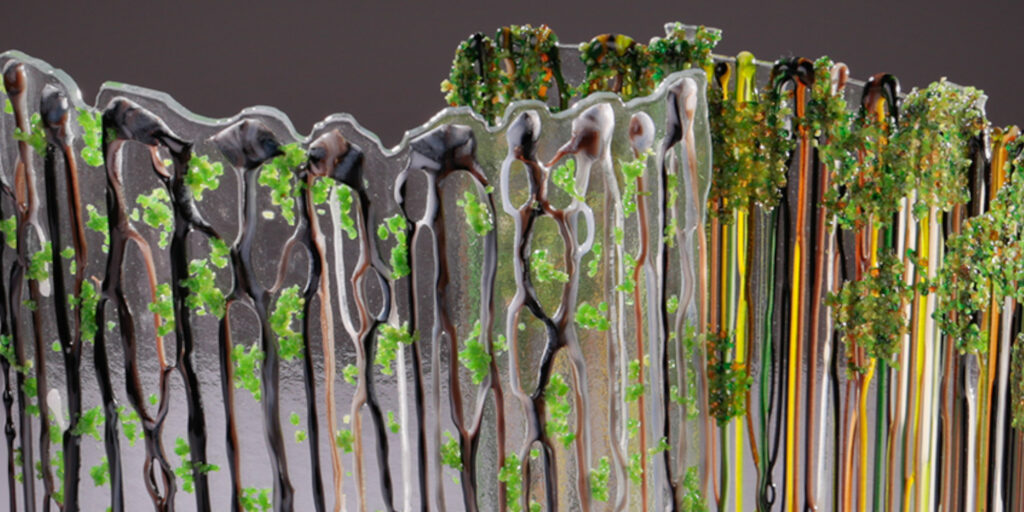
Image: Kay Vidler | Reflections (detail) 2022 | Ceramic | 305mm x 229mm x 76mm
ESSENCE Curatorial Essay by C.A Simpson Curator: Western Downs Regional Artists’ Exhibition, 2023
This year the theme of the Western Downs Regional Artists’ Exhibition is ‘Essence’. With a record number of entries, the works were diverse, compelling and of an excellent standard. The entries collectively told the story of a creative region filled with passion, talent, consideration, and inquisitiveness. The term essence comes from the Latin word ‘esse’, meaning ‘to be’. This cuts to the heart of the theme – to search for the substance that makes up the be-ing of a thing. The selected artists explore this idea from various perspectives. The theme posed a challenge for artists to strip the superfluous layers of their subject, to reveal its essence, its core. Some artists provided artworks reflecting the essence of their practice, distilling and deconstructing their ideas into a singular work. Many artworks explored the theme through the lens of people, place, time, or materiality.
The importance of identity, personality and personal connection is explored by several artists. Kylie Bourne, Kristin Flynn and Hallie Vickers looked inwards, exploring the essence of identity through self-portraits. Their artworks reveal further insights into the artists and their individual perceptions of identity. Bourne’s mosaic is a joyful celebration of her personality, skilfully created with meaningful materials. Flynn’s print provides layered meanings and reflects upon mortality and the reality of life. Vickers’ gouache painting distils her personality into a singular image, representing both her self-perspective and her family’s viewpoint.
Delving into personal connection and identity are artworks by Sarah Davis and Regina Hyland. Incorporating dogs, these artworks reveal the deep connections and wellbeing benefits that exist between human-animal partnerships. Davis’s textile work shares the artist’s vulnerability, strength and insight, observing positive mental health benefits and the healing nature of sharing a life with dogs. Hyland’s painting conveys the powerful and personal connection between her husband and his dog, Zeus, as they share their quiet morning ritual.
The essence of humanity and human transformation is explored in artworks by Josephine Forster, Mr Mouth, Meg Stevenson, Tiana Tramosljika and Linda Wilkes. Tramosljika’s digital print pursues humanity as a complex divide between the physical body and emotional soul. Forster’s painting focuses on the meaning of being human, symbolised by a butterfly of hope. Mr Mouth’s digital print pushes the boundaries of portraiture to reflect the artist’s intention, representing a broken heart. While these works all explore what it is to be human, not all feature portraiture, pushing the boundaries of the human as a subject towards the core of the artist’s intention.
Anna Moeba, Meg Noack and Bill Perry’s artworks bring the human subject back to the human form. Perry reduces the human form to an elegant, essentialist outline. Conversely, Moeba’s portrait recognises the various roles a person plays in the community and at home. Noack’s drawing merges family stories with the faces of ancestors, bringing storytelling and history to the fore.
The intersection of people and place provided inspiration for Cindy Grimes and Lillian Stiller. Grimes’ vibrant painting of a marketplace captures the place’s essence animated by people. Stiller’s painting shares an imaginary place serving as an aspiration for her future self.
Essence of the moment is revealed in artworks by Norm Clarke, Maree Easton, Kerri Haslem, Tracy Ryan and Melody Walker. Easton’s painting stills a moment of movement – sunset, tides and life – to provide a pause for reflection and breath. Similarly, Haslem’s painting captures the moment light passes through the vessel, sharing that beauty in oils. Ryan’s photograph stills the drama of the ethereal, ephemeral aurora that shows us nature-defying colours evoking the mystical power of the earth. Walker’s painting challenges us to think differently about the landscape, capturing the gradient twilight sky looking upwards into eucalypts. Clarke’s drawing shifts our focus back towards the vista, simplifying the landscape’s complexity to precise, evocative lines. These artworks draw on the human experience of fleeting time.
Looking beyond the human experience and instead towards elemental forces are artworks by Seth Gerke and Chris Osborne. Gerke’s timelapse video of weather events across the Western Downs builds tension, which resolves into rainstorms accompanied by a soundtrack enhancing the inherent drama. Osborne’s gouache painting carries power in the vibrant fire that consumes a tree in the landscape. These two works show us the impact of the elements on the landscape.
Helen Dennis, Laura Heath and Katie Robertson’s artworks interpret images of life through the landscape. Dennis’s painting portrays the environment carrying man-made and natural elements that merge over time into a harmonious and singular landscape. Heath’s photograph captures a native water lily and water ripple, hinting at a hidden world beneath the surface. Robertson’s cotton boll photograph reveals layers of life from the literal through to the metaphorical, sharing the importance of industry in the region.
The landscape is examined in macro by Patricia Hinz, Donna Rivers, Lisa Stiller and Peter Van Der Veen. Hinz’s painting incorporates pigments collected from the subject site, and looks underfoot to ground details including rocks, moss and lichen. Rivers’ painting reveals the hidden world in the depths of a lagoon. Stiller’s work on paper focuses on the details of eucalyptus leaves gilding them in metals to reveal the artist’s essence of the bush. Van Der Veen’s photograph explores a location’s spiritual essence, where the symmetry allows us to fall into the image, perceiving possibilities and potentialities.
Steve Cant and Samantha Wearing’s artworks ponder nature’s perseverance. Cant’s sculpture narrates the power of nature and its perseverance against disruptive forces. Wearing’s painting brings attention to bees’ persistence, whose actions produce chain reactions generating enormous impact.
Materiality as a theme response is visible in artworks by Guy Breay, Christopher Rigg, Jayne Rohrlach and Kay Vidler. Breay’s sculpture incorporates salvaged timber from his forest farm, which warms and sings with an inner glow from its light. Rigg’s sculpture, alternatively, focuses on the challenge of working with a timber burl and responding to the variations of grain and knots within the material. Working with raku clay, Rohrlach’s hand-built form shares the artist’s passion for this material. Vidler’s ceramic work about friendship comprises two vessels fired in the raku technique. The masterful material manipulation allows the vessels to move and sway with each other, reflecting the relationship between friends and calling attention to its materiality.
This exhibition is a celebration of the diversity and wealth of visual arts practices across the Western Downs. The artists involved have responded to the theme with unique, inspiring and thoughtful interpretations. It reveals much about the relationship artists have with the Western Downs as both a place and community. Collectively, the artworks offer layered meanings that share the stories and experiences of a region.
